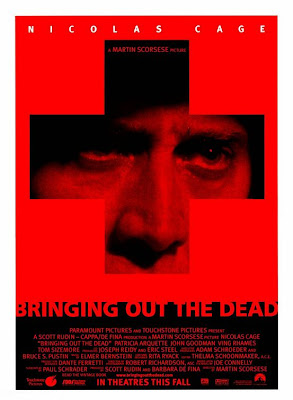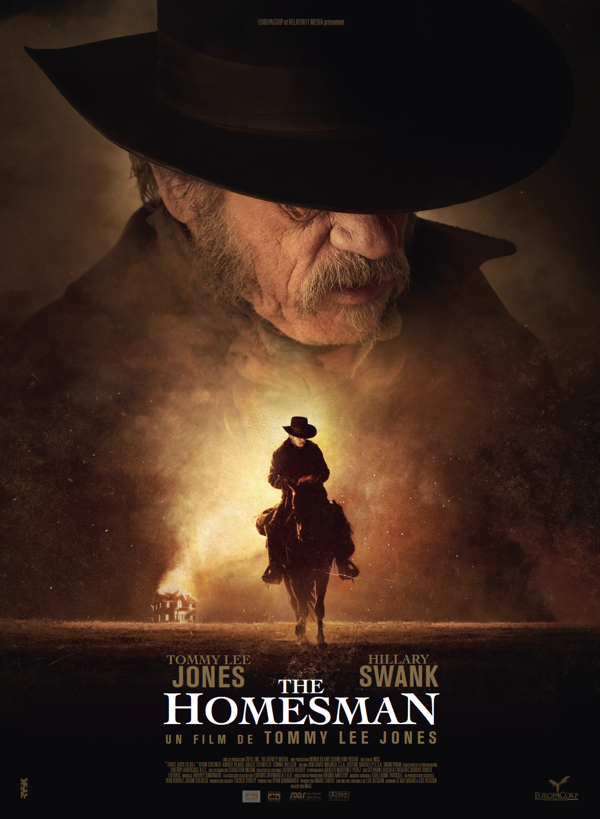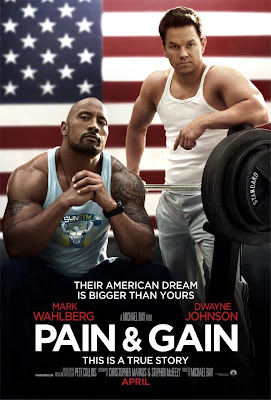Scorsese Flashback: Bringing Out The Dead
I was given the opportunity to provide a guest review of a film by
Martin Scorsese for Andy Swinnerton’s site, Rorschach Reviews, which got me so
excited that I asked if I could review two films. As a result, this is
the first of two new reviews I have written in regards to Scorsese’s past work,
covering his 1999 effort, Bringing Out
the Dead, starring Nicolas Cage.
Frank Pierce: Oh, I see. With all the poor people of this city who wanted only to
live and were viciously murdered, you have the nerve to sit here, wanting to die,
and not go through with it? You make me sick!
For a director spotlight review
on Martin Scorsese, my mind immediately leapt to his 1999 film, Bringing Out
the Dead. It is not that I think it is one of Scorsese’s best, though
I do really like it, but I find it to be a film that deserves to be talked
about more. It has less of a standard plot and more of a mood it wants to
convey by settling you in with Nicholas Cage’s burnt-out paramedic character.
It also contains some very good performances, another great soundtrack
from a director who loves music, and a more unrestrained look at Scorsese’s
kinetic visual style. Similar to how Casino put Scorsese back into
gangster-film mode, following The Age of Innocence, Bringing Out the
Dead came after Kundun and put the director back into territory he explored
with some of his earlier work – namely Taxi Driver, but with a darkly
comic edge.
The film takes place
over the course of three nights in early 90s Manhattan (specifically Hell’s
Kitchen). Frank Pierce (Cage) is a
burnt-out paramedic, working the graveyard shift in a two-man ambulance team. He is continually exhausted and depressed, with
the added notion of seeing ghosts walking the streets, particularly that of a
young woman he failed to save six months prior. Over the three nights, Frank is assigned with
a different partner during each of his shifts: Larry (John Goodman), Marcus (Ving Rhames),
and Tom (Tom Sizemore). During the first
shift we see, Frank befriends the daughter of a cardiac arrest patient he
brought in, Mary (Patricia Arquette), an ex-junkie. Frank spends much of the film dealing with
many people in the neighborhood in need of help, mainly due to the effects of a
new form of heroin that is hitting the streets. He also attempts to find some form of clarity
amidst the stress caused to him by his own psychological demons, which is aided
by the presence of Mary.
Bringing
Out the Dead was scripted by one of Scorsese’s best
collaborators, Paul Schrader (Taxi
Driver, Raging Bull), who based the script off of a novel of the same name
by Joe Connelly. The book was a
bestseller and the film was met with positive reviews, though it still flopped
at the box office. Despite the Scorsese
brand (which is only occasionally successful) and the drawing power of Nic Cage
(who is a wild card at the box office), Bringing
Out the Dead faded into obscurity pretty quickly, but it is a film that has
not gotten past me.
I do not want to spend
a whole lot of time comparing this film to Taxi
Driver, as the similarities are easy enough to spot, but not something I
want to focus on, and because Taxi Driver
is practically in a different league in terms of that film’s legacy. With that said, both films do have a central
performance from a character that is essentially lost in his life. While Travis Bickle is suffering from PTSD,
among other problems, Frank is dealing with being burnt out by the job. He has seen a lot of death and does not sleep
well because of it. At the same time,
while we are not seeing a truly harsh side of New York, like certain areas that
Taxi Driver explores, Bringing Out the Dead is not without its
rougher parts. Given that Frank and his
various partners are dealing with an assortment of different people suffering
from drug-related problems, among other things, it would be hard not to
recognize the grittiness of the Hell’s Kitchen depicted.
Cage really is pretty
great in this movie though, providing what is arguably one of his best
performances. Nicolas Cage has certainly
become synonymous for many with the punch line of movie star jokes, but I
continue to find him fascinating to watch on screen, as he is always giving it
his all. Of course, it really all comes
down to the screenplay and character that has been written, and Frank is the
type of character that plays to Cage’s strengths, as the man is unhinged, but
not completely overboard in this film.
We see him suffering physically, as his eyes clearly indicate that he is
ready to get into a bed and sleep for years, yet he cannot seem to allow
himself to do that and is distressed by what he has seen in his work. At the same time, Frank is great at his
job. When he is at work, he knows what
to do and how to handle the situation; it is just unfortunate that he has to
deal with so many lost causes. He is
less aware of how to communicate with certain people, such as Mary, but he is
also appropriately matched by the various other paramedics he is partnered up
with.
In these roles,
Goodman, Rhames, and Sizemore all bring a great level of energy to their parts
that are different for each character.
Goodman is doing his job and eats to help himself be content with his
responsibility. Rhames takes on the
guise of an evangelical preacher during his shift. Sizemore uses his own rage against
junkies. These are solid character roles
for each actor to work with and it does not stop there. Patricia Arquette’s character may have only
one emotional place to be coming from, as she deals with the concept of a
father she has had a tough time loving possibly approaching his death, as he is
continually defibrillated and brought back to life in the ER, but she is good
in the role. Her vulnerability is paired
well with Cage, who interacts with her in ways that are smart enough not to
resort to simply having them become romantically entangled. Also worth noting is the performance by Cliff
Curtis as a drug dealer who operates a drug den and refers to it as an oasis,
which seems like a place for Mary to find solace, even though Frank knows
better, but must tread lightly. It is a
credit to the film that you can accept this drug dealer character and even find
him likable, despite knowing that he is up to no good, given his profession.
It would be interesting
to read more about how people reacted to Scorsese’s direction in this
film. From a technical standpoint, I
think Bringing Out the Dead is a
fantastic version of Scorsese going into overdrive to really convey the world
that Frank is living in. Watching a film
that takes place predominantly at night and mostly from in or around an ambulance
gave way to seeing this vehicle careen down streets and serve as the chariot in
which Frank languishes in, as we come to learn more about him and what has him
so burnt out inside. The leading cause
of his unsettled nature becomes a recurring visual motif of a dead girl, which
is played up quite well through the use of some clever visual effects. The film’s visual aesthetic is wonderfully
suited to this film, as is the eclectic soundtrack which is filled with songs
from many classic rock groups including The Who, The Clash, and Van Morrison,
but makes way for other music choices that may seem odd, but end up working
very nicely into a film that features characters already pushed to their
limits.
Regarding what holds
this film back, Bringing Out the Dead
has no real specific problem, were one to be accepting of how the film is
presented in general. If one is not on
board with Cage or the film to begin with, then I can see a lack of really
appreciating it. If I had to narrow down
some issues, it would be how the film’s energy seems to dip in its final twenty
minutes. There is a certain event that
brings Frank to the top of a building where he has a conversation with a
character who is in a convincing amount of pain. That point in the film tends to always have
me thinking we have hit some sort of climax, when the film does in fact have
more to work with afterward. As a
result, I tend to find myself thinking we are wrapping up for quite some time,
as the film eventually reaches its end.
Given that the film is entertaining in spots, but also reliant on a
certain type of subject matter, spending the amount of time that we do can be a
little trying, if the film lessens on its own energy.
In writing all of this
I have attempted to understand more as to why this feels like such a standout
film for me. I have only watched it in
full a few times, but always find it very interesting and tend to question why
it did not do better. Cage is great
amongst many in a cast that all deliver strong performances. Scorsese is not restraining himself in anyway
or falling victim to convention, as Schrader’s script is different from many
plot-driven films. And for a film about
paramedics becoming affected by the amount of life and death they must contend
with on a nightly basis, Bringing Out the
Dead is a very entertaining film, with lots of darkly comic bits scattered
throughout. I guess that is where my
fondness for the film lies. While it
sits outside the realm of the more “important” films in Scorsese’s oeuvre, it
is a film that appeals to my sensibilities and arrived at a time when I was
really growing into my appreciation for film (it arrived in theaters a week
after Fight Club, which does sit on
the top for me). If Bringing Out the Dead is considered one of Scorsese’s “forgotten
films”, then taking some time to check it out would not at all be the worst
thing to do, as it has a lot of good to discover within it.
Dr.
Hazmat: I thought you said this guy was dead.
Frank Pierce: He got better.
Frank Pierce: He got better.
Aaron
is a writer/reviewer for WhySoBlu.com.
Follow him on Twitter @AaronsPS3.
He also co-hosts a podcast, Out Now with Aaron and Abe, available via iTunes or at HHWLOD.com.
He also co-hosts a podcast, Out Now with Aaron and Abe, available via iTunes or at HHWLOD.com.












Comments
Post a Comment